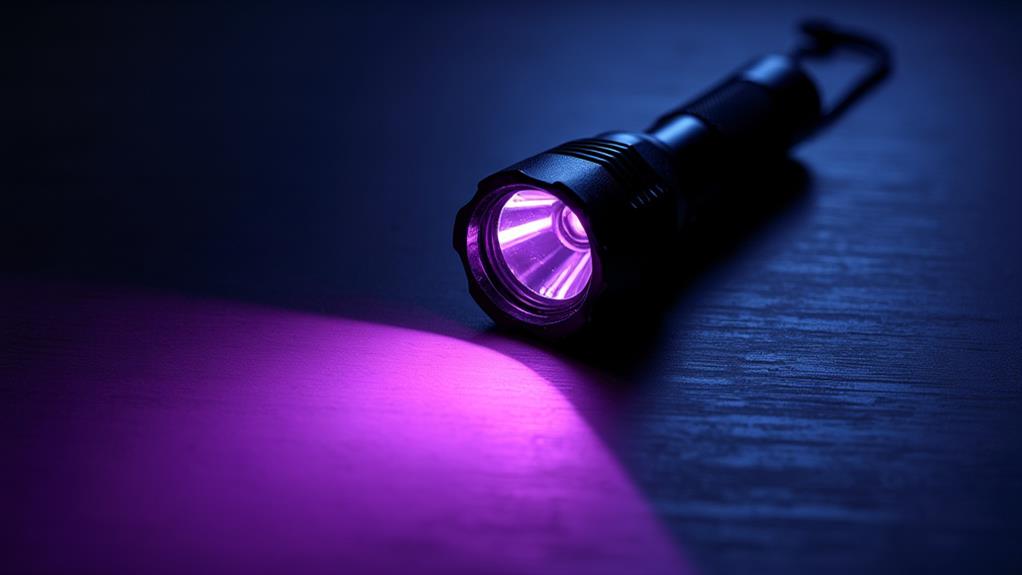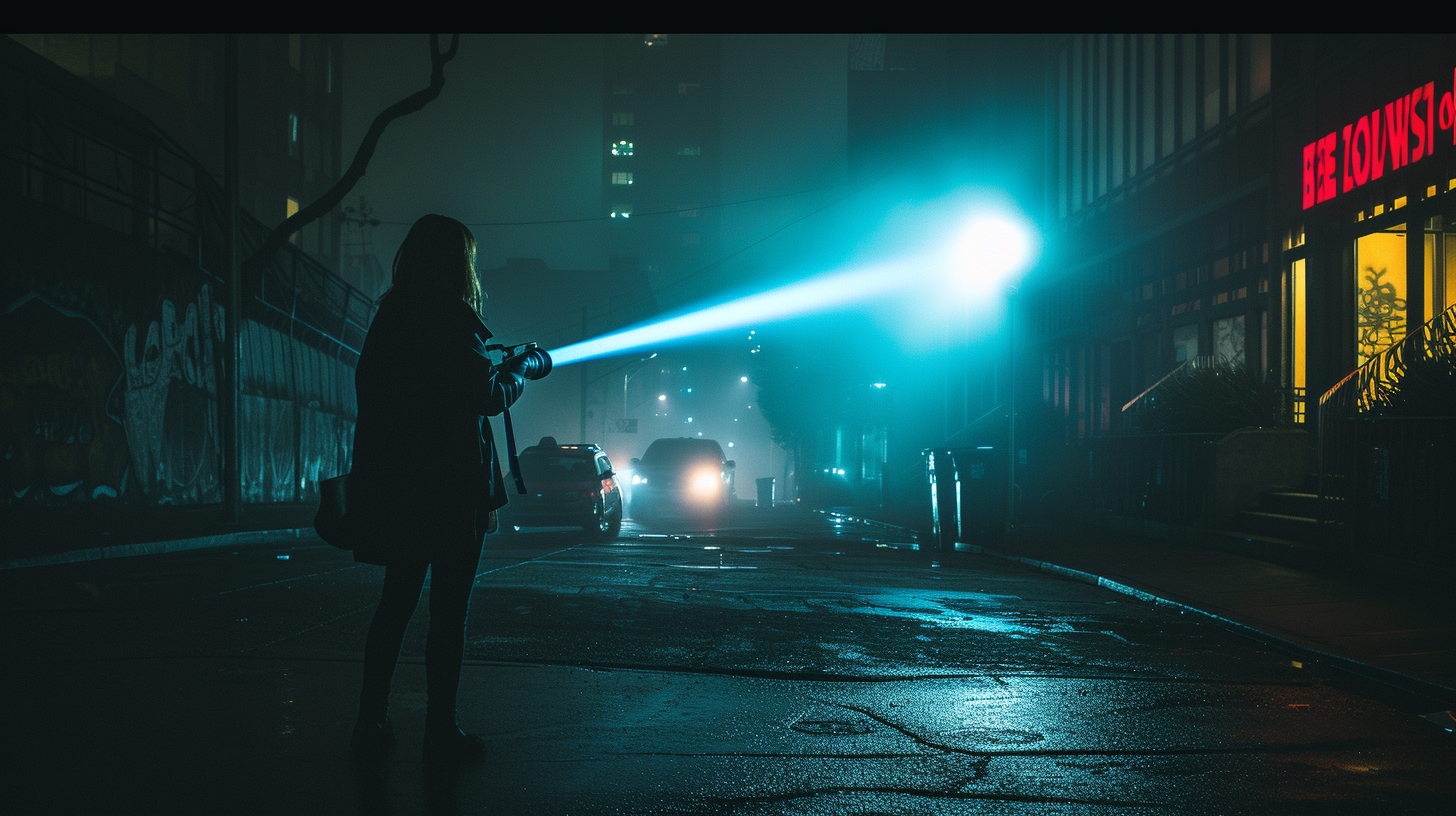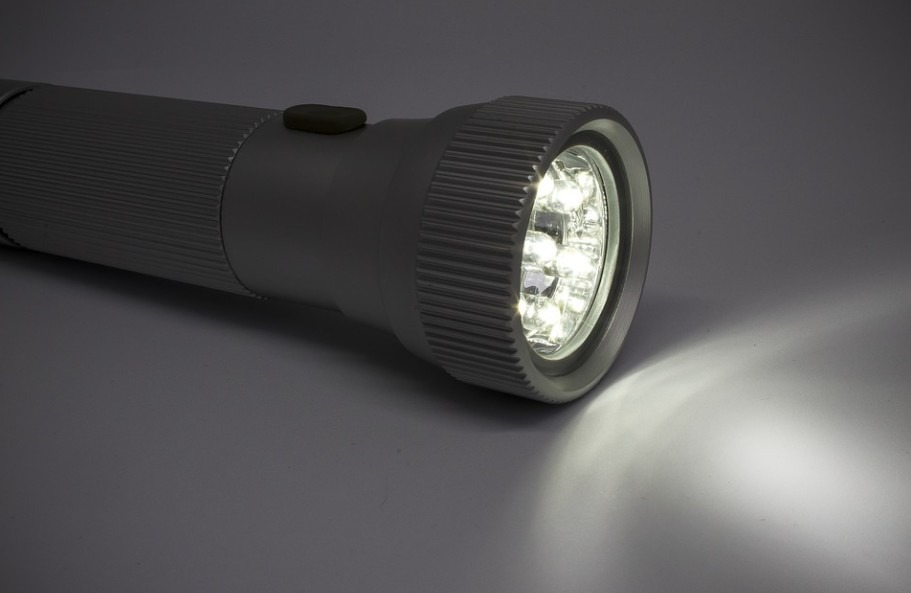What Does a Black Flashlight Do?

When you hear about a black flashlight, you might wonder what sets it apart from regular ones. Unlike standard flashlights, a black flashlight emits ultraviolet (UV) light, particularly in the UVA spectrum, which is invisible to the naked eye. This unique feature allows it to reveal things you normally can't see, such as hidden stains, counterfeit currency, or bed bugs. This tool is essential in various fields, from forensic investigations to hotel cleanliness checks. Curious about its workings and applications? Let's investigate further.
Overview of Black Flashlights

Black flashlights, also known as UV flashlights, emit ultraviolet light primarily in the UVA spectrum, which is invisible to the naked eye. These devices reveal fluorescence effects, making visible substances and details hidden under normal light. For instance, in forensic investigations, UV light can identify bodily fluids and hidden stains that are otherwise undetectable.
UV flashlights are also effective for verifying the authenticity of currency and identification documents, as many security features, such as special inks and strips, fluoresce under UV light. Shining the UV light on these items allows for easy detection of these features, helping to identify counterfeits.
For pet owners, a black flashlight is invaluable for locating urine stains on carpets and furniture, as these biological materials often glow under UV illumination. This makes cleaning and maintaining your home more manageable.
In geology, UV flashlights are useful for mineral hunting. Many minerals and gems exhibit fluorescence under UV light, aiding in their identification and classification.
Types of Blacklight Flashlights
Ever wondered about the various types of blacklight flashlights and their specific uses? Understanding the different options and their benefits can help you choose the right one for your needs.
- Fluorescent Blacklights: These utilize phosphors to emit UV-A light. The BLB (blacklight blue) types have a dark blue filter that reduces visible light, making them ideal for decorative and forensic applications. They create a dim violet glow, perfect for revealing hidden details.
- LED Blacklights: Modern and energy-efficient, LED blacklights generate UV light and boast a long lifespan. While they generally emit fewer wavelengths shorter than 380nm, they are favored for their durability and low energy consumption. LED blacklights are great for long-term use in homes and businesses.
- Compact Fluorescent Blacklights: Smaller and more energy-efficient, these are suitable for home use. They offer an accessible way to utilize UV light for various applications, from detecting pet stains to authenticating banknotes.
Each type of blacklight flashlight has unique advantages, whether you need a long-lasting, energy-efficient light source or a powerful UV light for specific tasks. There's a blacklight flashlight designed for your specific requirements.
How Black Flashlights Work

Black flashlights emit UV light, causing certain substances to fluoresce and reveal hidden details. Utilizing UV-A radiation, particularly at wavelengths around 365 nm, these LED-based tools help detect stains or materials invisible under standard lighting. Understanding this mechanism allows for effective use in various applications.
UV Emission Process
Although invisible to the naked eye, a black flashlight emits ultraviolet (UV) light, predominantly in the UV-A range. This UV emission process leverages specific LED technologies or fluorescent tubes to convert electrical energy into UV radiation, typically around 365 nanometers. This wavelength is crucial for activating materials embedded with fluorescent dyes, causing them to glow.
Here's how black flashlights achieve this:
- Emission Source: UV light is generated using LEDs or fluorescent tubes, which are optimized to emit UV-A light efficiently. This ensures that the flashlight can reveal hidden details under UV exposure.
- Filtration: Many black flashlights include filters to minimize visible light output, enhancing the fluorescent effect by reducing interference from other wavelengths.
- Efficiency: The efficiency of UV emission can vary among models. Some are highly efficient, directing a significant portion of their output to UV light, while others may emit less than 5% of their energy as UV light.
Proper maintenance, such as regular lens cleaning and battery checks, is essential for consistent UV output. Understanding the UV emission process of your black flashlight allows you to maximize its applications in forensics, counterfeit detection, and cleanliness verification.
Fluorescence Detection Mechanism
Imagine shining a UV flashlight in a dark room and suddenly, hidden details come to life. This phenomenon occurs due to fluorescence. UV flashlights emit ultraviolet light, specifically in the UV-A range, around 365 nm. While this UV light is invisible to the human eye, it is powerful enough to excite electrons in certain materials. When these electrons return to their ground state, they release energy as visible light, creating a bright glow.
Fluorescence relies on the unique chemical compositions of different substances. For example, bodily fluids, specific dyes, and various minerals can fluoresce under UV light. When exposed to UV light, these materials absorb it and re-emit it as visible light, making them stand out in a dark environment.
The effectiveness of fluorescence detection depends on several factors, including the intensity of the UV light, the distance between the UV flashlight and the target, and the levels of ambient light. In fields such as forensics, counterfeit detection, and mineralogy, UV flashlights are invaluable tools, revealing details that would otherwise remain hidden.
Forensic Applications
Black flashlights are indispensable in forensic investigations, providing a crucial tool for discovering hidden evidence. They play a significant role in uncovering details that might be overlooked by the naked eye. Here are three primary ways blacklights enhance forensic work:
- Latent Fingerprints: Blacklights cause certain substances in sweat to fluoresce, making fingerprints at crime scenes more visible and easier to analyze.
- Bodily Fluids: UV-A radiation from black flashlights reveals bodily fluids like blood and urine, which are typically invisible to the naked eye.
- Fiber and Material Detection: They assist in identifying specific fibers and materials from clothing or carpets, thereby linking suspects to crime scenes.
Forensic experts utilize blacklights to detect and analyze the presence of certain chemicals or drugs that fluoresce, a capability that is invaluable during drug investigations. Additionally, blacklights are essential for document examination, as they can uncover alterations or fraudulent activities by revealing hidden ink and security features on identification cards and other critical documents.
Counterfeit Detection

A UV flashlight can reveal hidden security strips in U.S. bills of $5 and higher, making it a valuable tool for detecting counterfeit money. It also helps authenticate government-issued IDs, licenses, and passports by exposing specific markings that fluoresce under UV light. This added layer of security protects against fraudulent cash and documents in transactions.
Reveal Hidden Security Strips
A UV flashlight is a powerful tool for detecting counterfeit currency. It uses ultraviolet light to reveal hidden security features embedded in U.S. bills, such as the security strips that glow under UV light. These features are present in all U.S. currency denominations of $5 and higher, aiding in the identification of counterfeit notes.
Here's how to use a UV flashlight for counterfeit detection:
- Inspect the Security Strip: Shine the UV light over the bill to reveal the security thread, which will glow in specific colors unique to each denomination.
- Check for Bleached Bills: Some counterfeiters bleach lower denomination bills and print higher values on them. The UV light can expose these by revealing the original security features.
- Verify Foreign Currency: Many international currencies also incorporate UV security features, making UV flashlights valuable for travelers and businesses dealing with foreign cash.
Authenticate Government-Issued IDs
Using a UV flashlight to authenticate government-issued IDs can significantly enhance your ability to detect counterfeits. UV flashlights reveal hidden security features that are not visible under regular light. Many IDs contain holograms and UV-activated inks that fluoresce under UV radiation, providing a reliable method for confirming authenticity.
When you expose an ID to a UV flashlight, specific UV patterns should illuminate, indicating the ID's genuineness. Counterfeit IDs often lack these intricate security features or may fluoresce incorrectly, making them easier to identify. This makes UV flashlights an invaluable tool for spotting fakes and reducing the risk of accepting counterfeit documents.
In environments like bars, clubs, and airports, proper training on using UV flashlights for ID verification can greatly enhance security and reliability. By learning to recognize the unique UV patterns and other security features, you can confidently authenticate IDs and mitigate the risks associated with counterfeit documents. Incorporating UV flashlights into your verification process is a straightforward yet effective way to improve your counterfeit detection capabilities. Therefore, do not underestimate the power of UV radiation in ensuring the authenticity of government-issued IDs.
Pet Stain Identification
Pet owners often face the challenge of identifying and cleaning hidden urine stains that cause unpleasant odors and damage. A black flashlight, which emits ultraviolet (UV) light, can be an essential tool for this task. The UV light causes pet urine stains to fluoresce, making them visible even in dark areas. This allows you to easily spot and address stains that are otherwise invisible to the naked eye.
Here's how a black flashlight can help with pet stain identification:
- Spot Hidden Stains: UV light highlights the organic compounds in pet urine, revealing hidden stains on carpets, furniture, and floors.
- Efficient Cleaning: Identifying these stains helps you clean more thoroughly and eliminate odors, saving time and effort.
- Maintain Cleanliness: Regular use ensures a clean living environment, preventing odors from lingering and causing long-term damage.
Using a black flashlight makes the cleaning process quicker and more efficient by revealing missed spots that need attention. It's a simple yet effective method to keep your home odor-free and clean, maintaining a pleasant living space.
Auto Leak Detection

When it comes to maintaining your car's health, a UV flashlight can be invaluable for detecting leaks. These flashlights are essential tools for identifying refrigerant leaks in your car's air conditioning system. By illuminating fluorescent leak detector dyes added to the refrigerant, UV flashlights reveal hidden issues that could affect your vehicle's performance.
UV flashlights can also pinpoint leaks of motor oil, gasoline, and other fluids by highlighting the fluorescent traces they leave behind. This can save you both time and money on repairs by quickly identifying leaks that might otherwise go unnoticed.
Here's how UV flashlights aid in auto leak detection:
| Benefit | Details |
|---|---|
| Refrigerant Leak Detection | Illuminates fluorescent dyes in the refrigerant. |
| Motor Oil Leak Detection | Reveals fluorescent traces of oil. |
| Gasoline Leak Detection | Highlights fluorescent residues. |
| Cost Efficiency | Saves time and money on repairs. |
Using UV flashlights regularly in your automotive maintenance routine enhances troubleshooting efficiency and ensures your vehicle systems operate properly. These tools rely on the presence of fluorescent dyes, which glow under UV light, making leak detection straightforward and precise.
Bed Bug Detection
A black flashlight can be a game-changer for detecting bed bug infestations. These pests are notoriously difficult to spot with the naked eye, especially in hotel rooms, mattresses, and carpets. The UV light emitted by a black flashlight reveals the fluorescence of bed bug droppings and eggs, making them easier to identify during inspections.
Using a black flashlight for bed bug detection offers several benefits:
- Spotting Droppings and Eggs: Under ultraviolet light, bed bug droppings and eggs fluoresce, standing out against the background and making them much easier to locate.
- Identifying Blood Stains: Bed bugs leave behind small blood stains on sheets and mattresses. A black flashlight can help you spot these stains, indicating their presence.
- Preventing Infestations: Regular checks with a black flashlight, especially in hotel rooms, can help prevent you from bringing bed bugs home, saving you from future infestations.
Hotel Cleanliness Checks

Using a blacklight in your hotel room can reveal hidden stains on bedding and sheets, indicating whether the linens are genuinely clean. This straightforward method helps you evaluate the hygiene standards of your accommodation, ensuring a safer and more comfortable stay. By shining UV light on various surfaces, you can detect contaminants and make informed decisions about your travel environment.
Identifying Hidden Stains
Using a UV flashlight, you can uncover hidden stains that may be missed during routine cleaning in hotels. UV light causes certain stains, such as blood, urine, and semen, to fluoresce, revealing their presence on seemingly clean surfaces. Here's how to ensure your hotel room is genuinely clean:
- Check Bedding and Sheets: Shine the UV light over the linens. Fluorescent stains indicate that the sheets haven't been properly laundered.
- Inspect Furniture and Carpets: Move the UV flashlight across upholstered surfaces and carpets. Hidden stains will become visible under the UV light.
- Examine Bathroom Areas: Use the UV light in darker spots, like under the sink or around the toilet base, to detect missed cleaning areas.
Regularly using a UV flashlight during your hotel stays can reveal hidden hygiene issues, ensuring a safer and more pleasant experience. This tool provides peace of mind, knowing your room meets high cleanliness standards, enhancing your overall stay.
Assessing Linen Hygiene
Using a UV flashlight is crucial for evaluating linen hygiene during hotel cleanliness checks. UV light reveals hidden stains on hotel linens, such as blood, urine, and other bodily fluids, that are invisible under regular lighting. This helps determine if the linens have been properly laundered, ensuring the cleanliness of your room.
Many hotels now incorporate UV light into their inspection routines to identify potential contamination from previous guests. Studies have shown that a significant percentage of hotel linens can harbor invisible stains, making UV light an essential tool for thorough inspections.
As a guest, knowing that a hotel uses UV flashlights for cleanliness checks can boost your confidence in their hygiene standards. Hotels that implement these practices not only enhance their sanitation but also provide a higher quality experience for their guests. Next time you check into a hotel, you can rest easy knowing that UV light has ensured your linens are truly clean.
Enhancing Travel Safety
Peace of mind is invaluable when traveling, and ensuring the cleanliness of your hotel room plays a significant role in that. Using a UV light, you can reveal hidden stains on hotel bedding, including bodily fluids like blood, urine, and semen, making it easier to assess if the hotel linens have been freshly laundered before you settle in. Here's how you can enhance your travel safety by checking for cleanliness:
- Inspect Bedding: Shine your UV light over the bed sheets and pillowcases. If any stains are visible, request fresh linens immediately.
- Examine Towels: Use the UV light to check towels for hidden grime or stains, ensuring they meet your hygiene standards.
- Check Bathroom Surfaces: Scan the bathroom surfaces, including the toilet and sink, for any biological residues that might not be visible to the naked eye.
Safety and Health Considerations
When using black flashlights, it's crucial to consider the safety and health implications of UV-A exposure. UV radiation from these devices can irritate your eyes, causing discomfort. Long-term exposure increases the risk of cataracts and retinal damage. Additionally, prolonged exposure to UV radiation can accelerate skin aging and raise the risk of skin cancer. Therefore, implementing protective measures is essential to mitigate these health risks.
The World Health Organization highlights the importance of UV protection to reduce the hazards associated with artificial UV sources like blacklights. To protect your eyes, avoid direct exposure to the UV light emitted from black flashlights. Wearing UV-blocking safety goggles or sunglasses can significantly diminish the harmful effects of UV radiation. For skin protection, limit your exposure to UV light and consider wearing protective clothing when using these devices.




